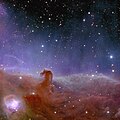File:Euclid’s view of the Horsehead Nebula ESA25170866.jpg

原始文件 (8,200 × 8,200像素,文件大小:1.84 MB,MIME类型:image/jpeg)
摘要
| 描述Euclid’s view of the Horsehead Nebula ESA25170866.jpg |
English: Euclid shows us a spectacularly panoramic and detailed view of the Horsehead Nebula, also known as Barnard 33 and part of the constellation Orion.
At approximately 1375 light-years away, the Horsehead—visible as a dark cloud shaped like a horse’s head—is the closest giant star-forming region to Earth. It sits just to the south of star Alnitak, the easternmost of Orion’s famous three-star belt, and is part of the vast Orion molecular cloud. [Image description: This square astronomical image is divided horizontally by a waving line between a white-orange cloudscape forming a nebula along the bottom portion and a comparatively blue-purple-pink upper portion. From the nebula in the bottom half of the image, an orange cloud shaped like a horsehead sticks out. In the bottom left of the image, a white round glow is visible. The clouds from the bottom half of the image shine purple/blue light into the upper half. The top of the image shows the black expanse of space. Speckled across both portions is a starfield, showing stars of varying sizes and colours. Blue stars are younger and red stars are older.] Tiếng Việt: Tinh vân Đầu Ngựa, còn được gọi là Barnard 33 và là một phần của chòm sao Orion |
| 日期 | 2023年11月7日 (上传日期) |
| 来源 | Euclid’s view of the Horsehead Nebula |
| 作者 | ESA/Euclid/Euclid Consortium/NASA image processing by J.-C. Cuillandre (CEA Paris-Saclay) G. Anselmi |
| 其他版本 |
|
| Activity InfoField | Space Science |
| Keyword InfoField | Horsehead Nebula Stars |
| Mission InfoField | Euclid |
| Set InfoField | Euclid First Images |

|
This image was selected as picture of the day on Vietnamese Wikipedia.
|
许可协议
This media was created by the European Space Agency (ESA).
Where expressly so stated, images or videos are covered by the Creative Commons Attribution-ShareAlike 3.0 IGO (CC BY-SA 3.0 IGO) licence, ESA being an Intergovernmental Organisation (IGO), as defined by the CC BY-SA 3.0 IGO licence. The user is allowed under the terms and conditions of the CC BY-SA 3.0 IGO license to Reproduce, Distribute and Publicly Perform the ESA images and videos released under CC BY-SA 3.0 IGO licence and the Adaptations thereof, without further explicit permission being necessary, for as long as the user complies with the conditions and restrictions set forth in the CC BY-SA 3.0 IGO licence, these including that:
See the ESA Creative Commons copyright notice for complete information, and this article for additional details.
|
 | |
本文件采用知识共享署名-相同方式共享 3.0 政府间组织许可协议授权。 署名: ESA/Euclid/Euclid Consortium/NASA, image processing by J.-C. Cuillandre (CEA Paris-Saclay), G. Anselmi, CC BY-SA IGO 3.0
| ||
说明
知识共享署名3.0政府间组织 简体中文(已转写)
image/jpeg
8,200 像素
8,200 像素
1,925,643 字节
7 11 2023
5qju5gik7a1tmf81iz4c7n0btv09ef7iz94girulklo143cu3c
共享资源质量评价 简体中文(已转写)
文件历史
点击某个日期/时间查看对应时刻的文件。
| 日期/时间 | 缩略图 | 大小 | 用户 | 备注 | |
|---|---|---|---|---|---|
| 当前 | 2023年11月7日 (二) 18:50 |  | 8,200 × 8,200(1.84 MB) | OptimusPrimeBot | #Spacemedia - Upload of https://www.esa.int/var/esa/storage/images/esa_multimedia/images/2023/11/euclid_s_view_of_the_horsehead_nebula/25170855-1-eng-GB/Euclid_s_view_of_the_Horsehead_Nebula.jpg via Commons:Spacemedia |
文件用途
没有页面链接到本图像。
全域文件用途
以下其他wiki使用此文件:
- fr.wikipedia.org上的用途
- he.wikipedia.org上的用途
- ru.wikipedia.org上的用途
- vi.wikipedia.org上的用途
元数据
此文件中包含有扩展的信息。这些信息可能是由数码相机或扫描仪在创建或数字化过程中所添加。
如果此文件的源文件已经被修改,一些信息在修改后的文件中将不能完全反映出来。
| 图像标题 |
|
|---|---|
| 数据生成日期时间 | 2023年10月29日 (日) 00:00 |
| 像素构成 | RGB |
| 方向 | 正常 |
| 水平分辨率 | 1 dpi |
| 垂直分辨率 | 1 dpi |
| 使用软件 | GIMP 2.10.18 |
| 文件修改日期时间 | 2023年10月29日 (日) 09:54 |
| 原始文件唯一ID | xmp.did:93eb5251-7bdb-4a71-84ac-e2d7aedbd77e |
| IIM版本 | 2 |




